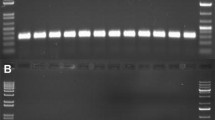Abstract
We described a simple and quick miniaturized sequencing gel system for DNA analysis. Two major modifications were made to the previously reported miniaturized DNA sequencing gel system to achieve high-resolution hydroxyl radical cleavage analysis: including formamide in the miniaturized gel and providing uniform heating during electrophoresis. Our method enables one to reduce the cost for chemicals and to significantly reduce electrophoresis time. Furthermore, minimal gel handling simplifies the entire process. We show that the resolution of DNA fragments obtained by hydroxyl radical cleavage for the miniaturized gel is similar to that of a large conventional sequencing gel.



Similar content being viewed by others
References
Greenbaum, J. A., Pang, B., & Tullius, T. D. (2007). Construction of a genome-scale structural map at single-nucleotide resolution. Genome Research, 17, 947–953.
Tullius, T. D., & Dombroski, B. A. (1985). Iron(II) EDTA used to measure the helical twist along any DNA molecule. Science, 230, 679–681.
Takasuka, T. E., & Stein, A. (2010). Direct measurements of the nucleosome-forming preferences of periodic DNA motifs challenge established models. Nucleic Acids Research, 38, 5672–5680.
Bishop, E. P., Rohs, R., Parker, S. C., West, S. M., Liu, P., Mann, R. S., Honig, B., & Tullius, T. D. (2011). A map of minor groove shape and electrostatic potential from hydroxyl radical cleavage patterns of DNA. ACS Chemical Biology, 6, 1314–1320.
Margolin, Y., Shafirovich, V., Geacintov, N. E., DeMott, M. S., & Dedon, P. C. (2008). DNA sequence context as a determinant of the quantity and chemistry of guanine oxidation produced by hydroxyl radicals and one-electron oxidants. Journal of Biological Chemistry, 283, 35569–35578.
Takasuka, T. E., Cioffi, A., & Stein, A. (2008). Sequence information encoded in DNA that may influence long-range chromatin structure correlates with human chromosome functions. PLoS One, 3, e2643.
Jain, S. S., & Tullius, T. D. (2008). Footprinting protein–DNA complexes using the hydroxyl radical. Nature Protocols, 3, 1092–1100.
Stein, A., Hill, S. A., Cheng, Z., & Bina, M. (1998). Simple miniaturized gel system for DNA sequence analysis. Nucleic Acids Research, 26, 452–455.
Maxam, A. M., & Gilbert, W. (1980). Sequencing end-labeled DNA with base-specific chemical cleavages. Methods in Enzymology, 65, 499–560.
Blake, R. D., & Delcourt, S. G. (1996). Thermodynamic effects of formamide on DNA stability. Nucleic Acids Research, 24, 2095–2103.
Acknowledgments
The authors thank the Department of Biological Sciences, Purdue University, West Lafayette.
Author information
Authors and Affiliations
Corresponding author
Rights and permissions
About this article
Cite this article
Takasuka, T.E., Hsieh, YJ. & Stein, A. Miniaturized Sequencing Gel System for Quick Analysis of DNA by Hydroxyl Radical Cleavage. Appl Biochem Biotechnol 172, 1–8 (2014). https://doi.org/10.1007/s12010-013-0512-8
Received:
Accepted:
Published:
Issue Date:
DOI: https://doi.org/10.1007/s12010-013-0512-8




